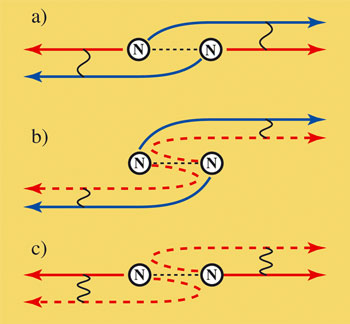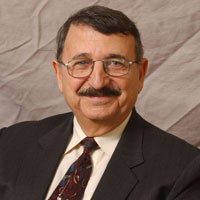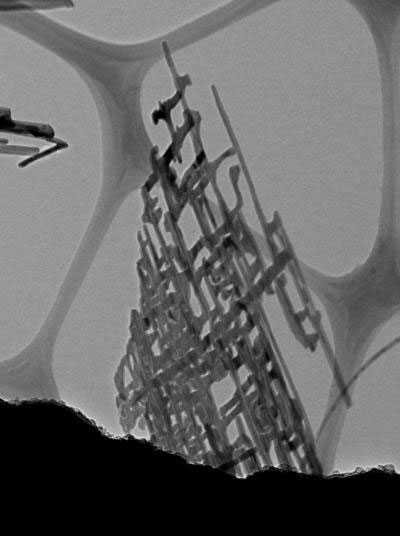Wissenschaftler wollen die grundlegenden Mechanismen der Reibung verstehen und untersuchen die Prozesse auf allerkleinster Ebene: im Nanobereich.
Sep 3rd, 2008
Read more
According to a new paper in the latest issue of Optics Express, the Optical Society's open-access journal, certain materials underneath an invisibility cloak would allow invisible objects be seen again.
Sep 3rd, 2008
Read more
 Electrons have something in common with people: the more information they acquire about their setting, the more they become aware of their individuality and the more belonging to a group loses its importance. As a result, the coherent harmony that binds the electrons into a fixed relationship with their environment is lost.
Electrons have something in common with people: the more information they acquire about their setting, the more they become aware of their individuality and the more belonging to a group loses its importance. As a result, the coherent harmony that binds the electrons into a fixed relationship with their environment is lost.
Sep 2nd, 2008
Read more
Researchers at the Broad Institute of Harvard and MIT today announced that they have been chosen to receive a six-year, $86M grant from the National Institutes of Health (NIH) to identify and develop molecular tools known as 'small molecules', which can probe the proteins, signaling pathways and cellular processes that are crucial to human health and disease.
Sep 2nd, 2008
Read more
 Mostafa El-Sayed, Regents Professor in Georgia Tech?s School of Chemistry and Biochemistry, has just been awarded the 2007 Medal of Science, the nation?s highest honor in the field.
Mostafa El-Sayed, Regents Professor in Georgia Tech?s School of Chemistry and Biochemistry, has just been awarded the 2007 Medal of Science, the nation?s highest honor in the field.
Sep 2nd, 2008
Read more
 Using two abundant and relatively inexpensive elements, Boston College chemists have produced nanonets, a flexible webbing of nano-scale wires that multiplies surface area critical to improving the performance of the wires in electronics and energy applications.
Using two abundant and relatively inexpensive elements, Boston College chemists have produced nanonets, a flexible webbing of nano-scale wires that multiplies surface area critical to improving the performance of the wires in electronics and energy applications.
Sep 2nd, 2008
Read more
A new electroplating process that simultaneously joins many silicon nanowires to many prepatterned electrodes was selected for a 2008 Nano 50 Award by Nanotech Briefs.
Sep 2nd, 2008
Read more
Using a novel technique, medical and engineering researchers at Stanford University have discovered a vulnerable step in the virus? reproduction process that in lab testing could be effectively targeted with an obsolete antihistamine.
Sep 2nd, 2008
Read more
Joint research by Semiconductor Research Corporation and National Science Foundation aims at ground-breaking solutions for problems challenging the electronics industry.
Sep 2nd, 2008
Read more
Researchers at the Royal Veterinary College (RVC) have developed a system that eliminates the need for antibiotics and resistance genes in the engineering of industrial and medical products.
Sep 2nd, 2008
Read more
The objective of the research is to design, fabricate and test an umbrella-shaped micro-actuator based on an integrated micro/nanofabrication technique for thrombus retrieval in stroke therapy.
Sep 2nd, 2008
Read more
The European Physical Society Condensed Matter Division is proud to announce the award of the 2008 EPS CMD Europhysics Prize to Andre Geim and Kostya Novoselov of the University of Manchester for discovering and isolating a single free-standing atomic layer of carbon (graphene) and elucidating its remarkable electronic properties.
Sep 2nd, 2008
Read more
Im Rahmen der NANO KOREA hat IVAM, Fachverband fuer Mikrotechnik, am 28. August 2008 den dritten Korean-German Micro/Nano-Business Workshop durchgefuehrt.
Sep 2nd, 2008
Read more
Scientists now realise that the precise molecular arrangements within natural pathways in organisms have been highly tuned for specific processes and provide both compounds that can be exploited directly and vital information over how to synthesise new products by mimicking biochemical processes.
Sep 2nd, 2008
Read more
IMEC and CEA-LETI launch ePIXfab, the continuation of their successful multi-project wafer silicon photonics prototyping service started in 2006.
Sep 2nd, 2008
Read more
A research project entitled 'A real-time analysis of the early diagnosis of cancer markers', undertaken by the CAS Changchun Institute of Applied Chemistry, recently passed the acceptance check by an expert team under the auspices of the National Natural Science Foundation of China.
Sep 2nd, 2008
Read more




 Subscribe to our Nanotechnology News feed
Subscribe to our Nanotechnology News feed